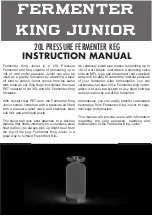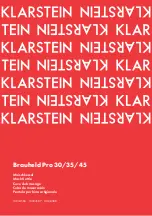
Chapter 12
LQG/H-Infinity Synthesis
Xmath Interactive Control Design Module
12-12
ni.com
Penalizing the “running integral” of the plant output forces the power
spectral density of the plant output to vanish at zero frequency. In classical
control terms, this forces a pole at
s
= 0 in the loop transfer function, that
is, integral control. As with PID design, the parameter
T
int
gives the time
scale over which the effects of the integral action will take place.
Exponential Time Weighting
When this feature is enabled, the plant is first changed to
P
(
s
–
a
), where
a
is the Decay Rate parameter. In other words, the plant is made less stable;
its poles (and zeros) are shifted to the right by the value
a
. Then, the LQG
controller for this “destabilized” plant is computed. Finally, the poles and
zeros of this controller are shifted left by the Decay Rate parameter
a
.
One effect of this shifting is that the closed-loop poles are guaranteed to
have real part less than the Decay Rate parameter
a
, or in other words, the
closed-loop time domain responses are guaranteed to decay at least as fast
as exp(–
at
). This is why the parameter is called Decay Rate.
Weight Editing
When
Weight Edit
is enabled, the LQG controller is based on
and
, which are filtered versions of the plant inputs and
outputs
u
i
and
y
j
(
). Without integral action, the
controller minimizes the quantity
and with integral action, the quantity
where
u
˜
i
W
u i
,
u
i
=
y
j
˜
W
y j
,
y
j
=
i
1
=
…
n
u
j
1
=
…
n
y
, , ,
, ,
J
E
t
∞
→
lim
x
T
u
˜
T
R
xx
R
xu
R
ux
R
uu
x
T
u
˜
T
ρ
u i
,
u u
˜
i
2
,
i
1
=
n
u
∑
ρ
y j
,
y
˜
j
2
,
j
1
=
n
y
∑
+
+
⎝
⎠
⎜
⎟
⎜
⎟
⎛
⎞
⎝
⎠
⎜
⎟
⎜
⎟
⎛
⎞
=
J
E
t
∞
→
lim
x
T
u
˜
T
R
xx
R
xu
R
ux
R
uu
x
T
u
˜
T
ρ
u i
,
u
˜
i
2
i
1
=
n
u
∑
ρ
y j
,
y
˜
j
2
y
˜
I j
,
2
+
[
]
j
1
=
n
y
∑
+
+
⎝
⎠
⎜
⎟
⎜
⎟
⎛
⎞
=
y
˜
I j
,
t
( )
1
T
int
--------
y
˜
j
ϒ
( ) ϒ
d
0
t
∫
=
















































